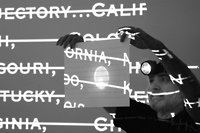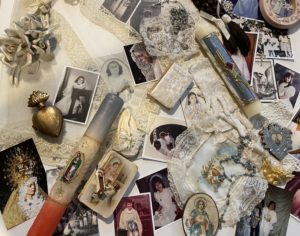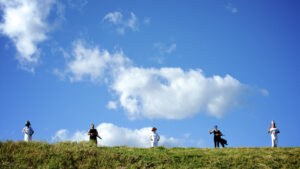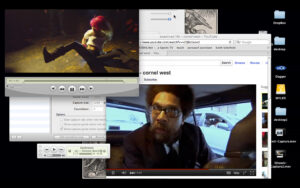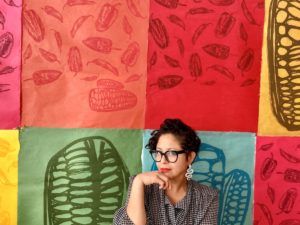Activity
Charles Garoian presents several classroom micro-performance ideas.
Media
Mixed media
Materials
Paper, pencil, rope/string/tape, umbrella, chair, water, newspaper, magazines, and various objects and materials from home
Download This Activity
PDF | Word Document
About Open Studio
Designed by practicing artists, the Open Studio classroom activities aim to connect high school teachers and students with key ideas and issues in contemporary art. See all of the Open Studio activities.
Assignments
Micro-performance #1
Identify a verbal pun. On paper, describe five different ways that the pun can be performed non-verbally. After gathering and assembling the necessary tools and materials, perform the pun in the five different ways that you described on paper.
Micro-performance #2
Take a household tool or item and perform its intended function for a period of three minutes. Then, for an additional three minutes, experiment by flipping and performing its function in three or more ways in which it was not intended. Create a two- to three-minute performance during which both its intended and unintended functions riff off each other.
Micro-performance #3
Using some tape, string, or rope, bind your feet together while you are in a sitting position. Then stand and, while balancing your body, begin to move against the restriction. Take note of the improvised movements that are emerging from your body. Then remove your bindings and perform the same movements for three minutes.
Micro-performance #4
While sitting with your eyes closed for five minutes, imagine your body performing a physically impossible task. In your mind’s eye, study and memorize your body’s impossible movements. Stand, open your eyes, and actually perform that task, rehearsing it in various ways several times, and then repeat them for three minutes. Rest for one minute. Then for another three minutes, perform your impossible task again, this time simultaneously with other bodies performing theirs.
Micro-performance #5
Write a one-hundred-word narrative that describes the most significant experience of your life. Describe it in detail according to what occurred, where it took place, who was present, and any other details. Then edit your narrative to a ten- to fifteen-word word-collage that depicts the essence of your significant experience. Perform your word-collage orally in the following ways: use a whispering voice, talking voice, and shouting voice; a collage of your three voices. Finally, perform your voice collage as part of a chorus with your classmates performing theirs.
Micro-performance #6
Using your body as an instrument, produce nonsense sounds, noises that characterize your significant experience in Micro-performance #4. Experiment with variations of your body sounds, and add them to your voice collage performance in Micro-performance #4.
Micro-performance #7
Identify five verb forms (e.g., to lean, to prop, to fall, to roll, etc.). Experiment with different ways to perform your verbs with your body. Perform a mash-up movement in which all five verb forms interconnect with each other. Then, brainstorm and collaborate with two others to create a mash-up of your respective verb performances.
Micro-performance #8
Given the forces of gravity, experiment and improvise a process by which to “float an idea” in the air. Use every means to keep it afloat. Join together with several others and float your respective ideas, in the air, together, while moving down a street as a group in a synchronized march.
Micro-performance #9
Given the forces of gravity and the submergibility of water, experiment and improvise a process by which to “walk on water.” Join with others in performing your “water walking.” Together, improvise “a parade float” composed of you and your classmates as you “water walk” together down a street.
Micro-performance #10
Find five objects that are unrelated in form, function, and size. Use duct tape, rope, wire, or string to attach the five found objects so that they dangle from different areas of your body. Move your body to motorize the objects in space. Perform your body motor for three minutes during which all five attached objects are in motion.
Micro-performance #11
Bring a found object from home that is strange and inconsistent with what is usually found in the art classroom. It should measure at least three feet in one dimension. Place it in the classroom, study its radical juxtaposition, and write a narrative of 150 words or more that discusses the various ways that the oppositional relationship between the object and the classroom mutates and alters your understanding of their familiar functions. Share your findings with your classmates.
Micro-performance #12
Find an umbrella and explore and experiment with the different movements and sounds produced by opening and closing its canopy. Create an improvisational umbrella performance composed of the various movements that emerge from your exploration. Then improvise a parade float composed of you and your classmates umbrella-walking together down a street.
Micro-performance #13
Find a chair and sit in it for approximately five minutes with your eyes closed. In your mind’s eye, imagine three “strange” ways that you can use the chair other than its “familiar” function. Open your eyes, stand, and begin to explore, experiment, and improvise those three strange functions with your body. Then perform them in a live, interconnected composition.
Micro-performance #14
Conduct a random search for words and phrases from several newspapers and magazines that capture your attention. Cut and arrange your findings onto a blank sheet of as a “word collage.” Move the words and phrases around the paper to create differing compositions and readings. Before moving from one composition to another, recite them into an audio or video recorder. Then play back your recitations as a “sound collage.”
Micro-performance #15
With a partner to assist you, collage your entire body with newspaper, magazine pages, and clippings taped together. Make certain that the pages and clippings are taped close enough to your clothes so that slight crackling sounds are heard when your body moves. Once your body is entirely covered, begin to perform the collage by moving your body in whatever way is necessary to produce the crackle of the paper. Ask your partner to join you in the performance by reading her/his word collage from Micro-performance #14.
